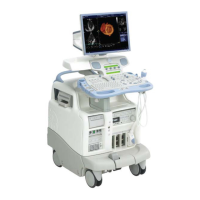GE HEALTHCARE
DIRECTION FC091194, REVISION 11 VIVID 7 SERVICE MANUAL
Chapter 5 - Components and Functions (Theory) 5 - 9
5-3-9 Transmitter and Receiver Subsystem
5-3-9-1 Transmitter Signal Path - Units With One TX Board
• The Front-End Controller board (FEP1) or the Radio Frequency Interface board (FEP2) loads scan
parameters via the FE_BUS into local RAM on the TX board and on the BF boards.
The scan parameters includes probe dependant steering and focusing delay for a certain scan
pattern. Thus, when the Front-End Controller board (FEP1) or Radio Frequency Interface board
(FEP2) goes through a scan sequence, it loads the proper contents of the RAM into the Transmitter
Pulse Generator (TPG), then issues a transmit trigger pulse (TXTRIG_L) for the transmitter and a
receive synchronization pulse (SYNC_L) for the Beam Formers.
By firing the transmit pulses from the different elements at certain repeated time intervals and with
different delays, the ultrasound beam can be steered in desired directions to obtain the selected
scan patterns (e.g. 2D, 2D Flow etc.).
• The ultrasound transmit bursts are generated on the TX board, initiated by the transmit trigger pulse
(TXTRIG_L). The transmit trigger starts the Transmit Pulse Generators (TPG) on the TX board,
each generating 16 transmit pulses with different delays. The transmit pulses are then routed to
separate transmit “amplifiers” fed with voltage HV1 and HV2. The voltages HV1 and HV2 are
controlled by the Acoustic Power Control software.
• The transmit pulses are routed over the Transducer Bus Board (XDBUS) located on the front side
of the TX and RX boards, to the Relay board, where they are fed to the selected probe.
Figure 5-5 The Ultrasound Transmitter with one TX board
RELAY
BOARD
RX128
TX128
FRONT-END CONTROLLER
(UNITS WITH FEP1)
RFI BOARD
(UNITS WITH FEP2)
PROBES
DOPPLER PROBE
DIGITIZED RECEIVED
ULTRASOUND SIGNALS TO:
- RFT BOARD
(UNITS WITH FEP1)
- RFI BOARD
(UNITS WITH FEP2)
XD_BUS
BF64
FE_BUS
T/R

